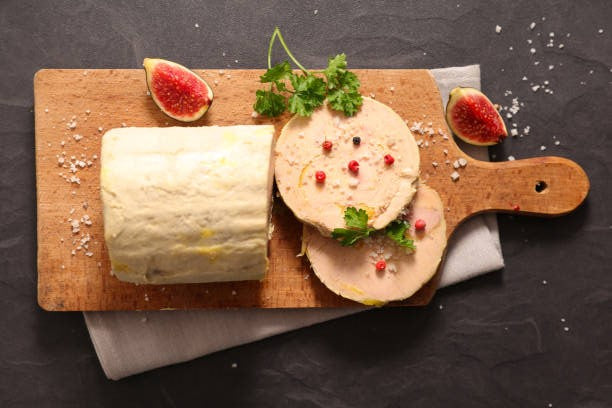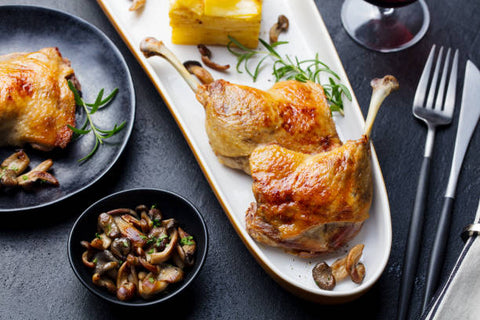Foie gras is a delicacy known for its distinct sweetness and decadently rich flavor, and it has been adored by people all over the world for years. Ducks that have been purposely fattened to generate livers that are bigger and more succulent than typical are used to make foie gras. While many people identify foie gras with pate, this gourmet delicacy can be enjoyed in a variety of ways. Here are some ideas for how to prepare foie gras if you're new to it. Let's take a closer look at what foie gras is and how it may be consumed to gain a better grasp of how to eat and enjoy it.
It's a classy way to present foie gras. It's usually served as an appetizer (before the main course). It is occasionally used as the main meal, but this is unusual. Foie gras can be made from duck or goose, from Alsace or the South-West, whole, in blocks, jars, or logs, truffled or plain, and it offers gourmets a limitless variety of culinary combinations.
Preparation
In France, the majority of foie gras recipes are prepared at a low temperature since traditional goose foie gras melts more quickly than duck foie gras produced in the majority of other parts of the world. More recipes and dish preparations for serving foie gras heated rather than cool or cold may be found in British and other New World cuisines, which often use duck foie gras as their primary ingredient. It is also served warm after it has been fried or roasted, with some chefs smoking the foie gras over a cherry wood fire. In Hungary, goose foie gras is cooked in goose fat before being poured over it and left to cool. In other parts of the world, foie gras is used in a variety of dishes such as sushi rolls, various varieties of pasta, and as a topping for steaks.
Cold preparations
Foie gras terrines, mousses, parfaits, pâtés, and foams are made using traditional low-heat cooking methods and are frequently flavored with mushrooms, truffles, or alcohol like as armagnac or cognac. Foie gras is served at room temperature or below after it has been slowly cooked. Raw foie gras is served slightly chilly in addition to being salty (cru au sel).
Hot preparations
Foie gras is increasingly found in hot preparations not just in the United Kingdom, but also in France and other countries, as a result of expanding internationalization of cuisines and food sources. Even though foie gras of duck (foie gras de canard) contains less fat and is better suited to cooking at more heat than goose foie gras (foie gras d'oie), chefs have been successful to create foie gras of goose using comparable procedures established for duck, albeit with greater caution. Paprika, salt, and black pepper are the most common spices added in heated foie gras. Fleur de sel has been used as a gourmet spice for heated foie gras by chefs because of its crunch.

1. Foie Gras Torchon
The term "torchon" refers to the traditional method of cooking foie gras. This cylinder of pure foie gras, which was covered in a towel, was poached using the original sous vide process. A torchon is a dishcloth in French. To mimic the historical allusion, food-grade plastic is increasingly being used to poach prepared torchon and marketed wrapped in muslin fabric.
2. Terrine of Foie Gras
The foie gras terrine, like the torchon, is called after the terrine mold that is used to produce it, which is usually porcelain. In a water bath, the entire raw liver is packed into a terrine and cooked at a low temperature to make this entrée. To enhance the rich buttery foie gras in a terrine, Sauternes wine (a great sweet white wine from France), pepper, and only salt are needed.
3. Mousse of Foie Gras
The word mousse comes from the French, which means froth or lather. Products with a light, airy texture and a creamy mouthfeel are referred to be emulsified liver goods. The greatest of them all is foie gras mousse. Made entirely of duck foie gras, Sauternes wine, sugar, and white pepper, ours is fully cooked and ready to eat, enabling the foie gras' inherent flavor to show through in each bite. Mousse can be flavored with black pepper, onions, and, herbs and occasionally vegetables or fruits, but we like black truffles in our foie gras mousse.
4. Medallion of Foie Gras with Black Truffles
We combine pure duck foie gras mousse with authentic black truffles to make our best foie gras medallion. This foie gras is elevated to new heights of delight by the earthy flavor of truffles. It's one of the most popular foie gras dishes at our restaurant, and it's also one of the most affordable.
How to eat foie gras
You must understand what foie gras is and how to prepare it before ordering it in a restaurant. When it comes to eating foie gras, there are many regulations to follow, but they all boil down to one simple principle: "Don't kill the true flavor." It's a shame to distract from this beautiful delicacy's flavor and perfume by serving it with a sour wine or a spicy side dish. Because of this crucial concept, experts recommend serving slightly chilled foie gras with plain bread. Butter is also regarded as a time-waster. Any extra sauces or seasonings are strictly forbidden, thus if you serve the dish with mayonnaise or ketchup, you will be ejected from a distinguished French household's table.
The best bread for foie gras
To shine in the kitchen, it is not always necessary to deviate from the norm. Bread is an important foil for foie gras, and good reason: it gives the dish substance and crunch, making it easier to eat, and depending on the type of bread you use, it could account for a significant portion your meal.
Stick to rye bread with a little toast or branch out and try specialty bread like those made with dried or candied fruit. Foie gras is best served with gingerbread toast. Its festive undertones, which harken back to warm winter evenings by the fire, are an obvious complement for this superb local product, not to mention its rich cinnamon, star anise, cloves, and ginger flavor.
Accompaniments for foie gras
Fried duck or goose liver is usually served with a light green salad without dressing and a slightly acidic fruit-berry sauce. Oyster mushrooms and chanterelles are ideal for this recipe because they have a milder aroma than white mushrooms. High-calorie foods, of course, have no place on a foie gras escalope platter (such garnishes like potatoes, rice, vegetables fried in oil, and others). Let's talk about some more delicious additions that will make your holiday meal the best it's ever been.
- White pepper and baguette
It's the most traditional way of cooking duck liver. a slice of foie gras freshly ground white pepper, and white bread It's critical not to spread the foie gras on the bread (as this is how pate de foie gras is traditionally served), but rather to arrange a piece on top. The flavor of foie gras is finest when the bread is warm and lightly toasted.
- Sauces made from fruits and berries
Foie gras pairs well with sweet jams, sauces, and marmalades that have a tinge of sourness. The flavor of duck or goose liver is enhanced by a subtle sweetness.
- Fig jams
We recognize the combination of fig jam and foie gras from a wide range of fruit and berry sauces since it is one of the best; as a consequence, it completely satisfies our taste buds.
- Baked Apples
Baked apples, which have a mild aroma and a silky texture, go nicely with foie gras. The addition of fresh lettuce leaves to this dish adds to its appeal.
- Onion Chutney
The sweetness of the fried onion complements our great delicacy, and the fresh flavor of the spices adds to the dish's elegance.
- Fried Mushrooms
Because of their delicate aroma, chanterelle mushrooms make ideal ingredients for pate de foie gras, which is why they are widely used in this recipe.
Foie gras and fruit: an exquisite combination
Serve foie gras with fresh or dried fruit to capture the essence of this regional delicacy. The sweet and sour harmony that everyone loves will be coupled with fresh fig, a bunch of grapes, half a pear, prunes, or a few almonds and hazelnuts. Finish the meal by adding coarse salt, freshly ground pepper, and a few berries over the foie gras slices.
The pairing of wine with foie gras
Many people have been intrigued by the mix of wine and foie gras. The equation turns out to be more complicated than it appears. While the combination of foie gras and sweet wine sounds appealing, the former is normally served as an appetizer and the latter is served at the end of the meal. Why not solve the problem by serving foie gras towards the conclusion of the dinner, without violating wine-tasting etiquette? If that sounds a little too fancy, remember that foie gras is usually served between cheese and dessert.
Of course, foie gras pairs beautifully with a dry white wine like Riesling or Chablis, or even champagne, which is ideal for piqueing your guests' appetites at the start of the evening. Are you presenting a strong-smelling duck foie gras? Match it with a tannic red wine like Mabel, Syrah, or Madiran to bring out the richness of the product.
Consumption
In the gourmet world, foie gras is a delicacy. In France, foie gras is typically served during réveillon feasts for special events such as New Year's Eve or Christmas, though it has recently become more widely available, making it a less unique dish. Foie gras is consumed all year in some parts of France. Duck foie gras is slightly less expensive and has been by far the most popular since the 1950s when the industry switched to battery manufacturing methods. Duck foie gras is described as having a musky flavor with a hint of bitterness. Goose foie gras is known for being smoother and less gamey than duck foie gras, as well as having a more delicate flavor.
Selecting the Best Foie Gras
The success of your dish will be determined by the quality of the foie gras, regardless of the garnish. Choose full semi-cooked foie gras from France, Alsace, or the Southwest as a result. With plain foie gras, you can get away with a few eccentricities, but with truffled foie gras, you should stick to more somber accompaniments to avoid overpowering the latter's subtleties. As an appetizer, serve 50 to 70 grams of foie gras per person, and 100 to 150 grams as a main dish.
More information about Foie gras serving
Foie gras is prepared from the liver of a goose or duck, and the ideal manner to serve it has changed over time to match changing culinary trends. It was customarily served after a meal. Previously, the dish was served with truffle and aspic, but many experts now consider that adding so many distinct flavors is unnecessary, therefore they prefer to serve it with warm, lightly toasted bread instead. Foie gras with green onions, pumpkin, and scallops is one of the newest trends. On the other hand, classic recipes keep to tried-and-true procedures and ingredients.
So, how do you serve foie gras pate, which is considered an haute cuisine masterpiece? Serve with plenty of sliced bread, a good sharp Dijon and/or wholegrain mustard, and cornichons for a unique presentation. Last but not least, when eating ducks liver, keep the following numbers and proportions in mind: 50-70 grams per person as an appetizer; no more than 150 grams of the fried liver as a full meal. Foie gras bread is the greatest bread.




